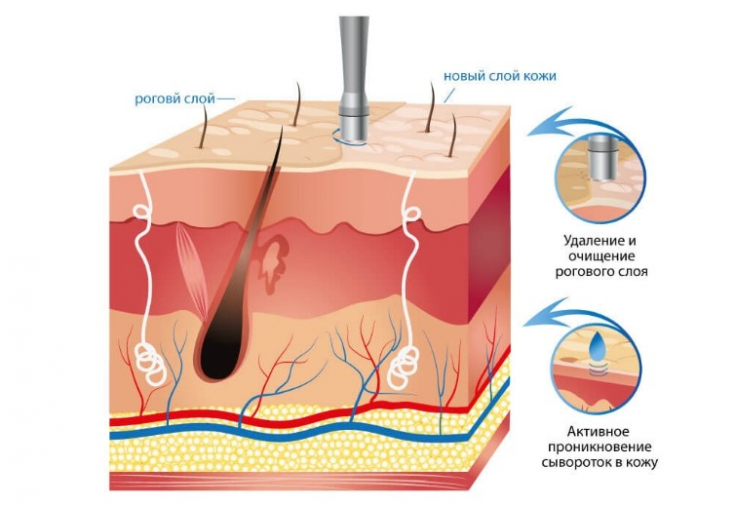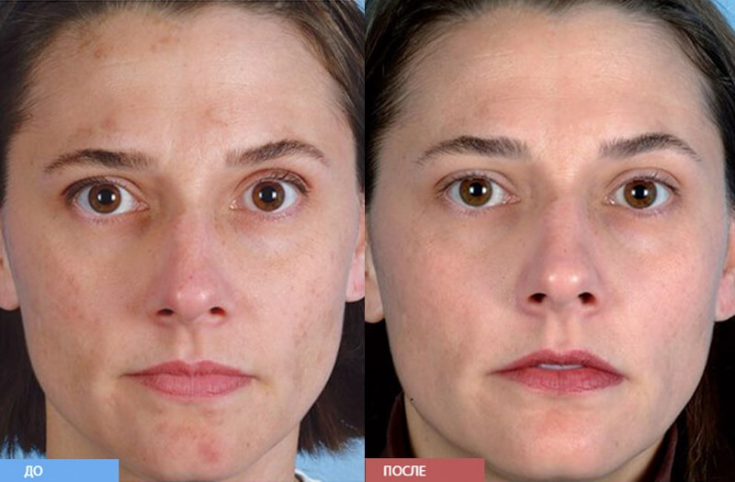Microdermabrasion is a minimally invasive epidermal renewal procedure used to correct uneven skin texture, signs of photoaging, stretch marks, melasma and scarring, including post-acne. During the procedure, abrasive crystals are moved over the surface of the skin under the control of a manual vacuum system. The crystals cause soft mechanical damage of the skin, eliminating the stratum corneum of the epidermis. During the healing process, a renewed epidermis is formed with an improved cosmetic effect. The technique is considered safe for all skin types Fitzpatrick, and complications are minimal. The benefits of microdermabrasion for aesthetic correction
- Indications and contraindications for microdermabrasion
- Microdermabrasion: technique
- procedures and complications Benefits of microdermabrasion for correcting aesthetic imperfections In addition to removing the stratum corneum
deeper layers
of the epidermis and dermis. The procedure causes rearrangement of melanosomes at thebasal layer of the epidermis, flattening of the reticular ridges at the dermal-epidermal junction, an increase in the density of collagen fibers at the dermal-epidermal junction, and vascular ectasia at xxxx>reticular dermis.
 Use of
Use of
of wound healing
and matrix metalloproteinasesin the dermis. Follow us on Instagram!
Biomechanical analysis after microdermabrasion shows a decrease in skin stiffness, an increase in elasticity and density
of the skin.Top 3 Popular Skin Resurfacing Treatments
Microdermabrasion has been shown to improve transdermal
delivery of insulin,vitamin C, lidocaine and 5-fluorouracil. Indications and contraindications for microdermabrasion The indications for
microdermabrasion are:Scars, including post-acne,
- Melasma, Photoaging,
- Small wrinkles, Enlarged pores,
- Seborrheic dermatitis .
- Post-Acne Treatment: Effective Techniques
Microdermabrasion is contraindicated for use in the area of acute and chronic infectious process
, including pathologies such as impetigo, herpes simplex virus, human papillomavirus, varicella-zoster virus.Microdermabrasion should be used with caution in people with a history of hypertrophic scarring. Rosacea and telangiectasia
are consideredrelative contraindications.
Microdermabrasion: procedure technique and complications
Eye irritation may occur if the crystals come in contact with the conjunctiva. There is also an increased
risk of reactivation of viral causative agents of skin lesions, such as molluscum contagiosum and latent herpes simplex virus, in the treated dermatome.
How to avoid side effects after microdermabrasionBecause microdermabrasion removes
the stratum corneum, the skin becomes more susceptible to photodamage. Patients should be advised to use sunscreen for at least one week
after the procedure.Follow us on Facebook!
During microdermabrasion, the eyes are covered with wet gauze to avoid contact withabrasive crystals. Contact occurs between the skin and the end of the device. With negative pressure, the device draws the skin into the handpiece.
 .
.
3xxx walks over the treated area.
Delicate exfoliation: the benefits of superficial peels Remaining
crystals and debrisare then removed and a mild moisturizer is applied. The entire procedure usually takes 30-60 minutes. Patients often require 4-6 sessions weekly to achieve desired results.
The degree of stratum corneum removal depends on the flow rate of the crystals and the exposure time of the procedure. The pressure generated by the vacuum device has little effect on the removal of the stratum corneum. While
Microdermabrasionis a relatively gentle procedure with minimal complications, all practitioners should receive training in the propertechnique, benefits, and risks
associated with the procedure. Patients should be advised that several treatments may be required to achieve desired results.
More interesting stuff on our YouTube channel:






